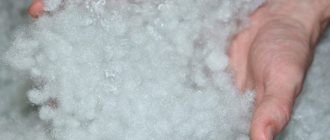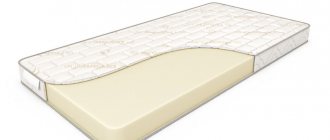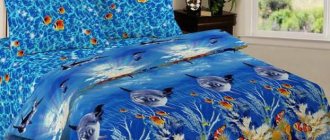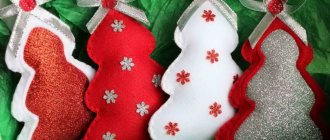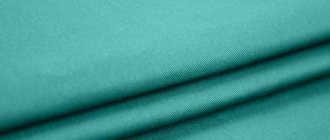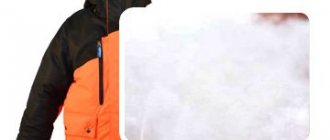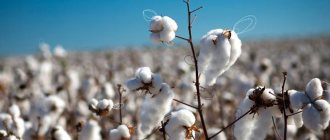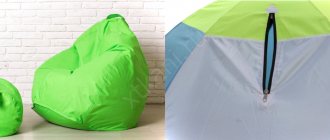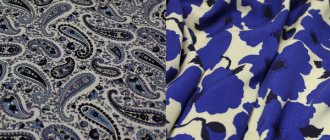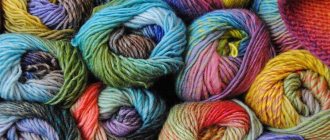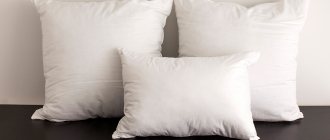Robert Valeev 01/20/2016 Useful information about equipment
Other articles on the topic of materials used in travel equipment:
- Basic fabrics
- Membranes
- Impregnations
- Accessories
Today we’ll talk about materials that save us from low temperatures – insulation.
As always, in this niche there is a confrontation between natural materials and synthetics, although in this case the natural material, and more specifically down, is still superior to synthetic ones in a number of parameters, but more on that later.
So, what are the materials designed to protect us from the cold?
We all probably remember from physics lessons that gases have the least thermal conductivity, and the most common gas is air, so the main task of most insulation materials is to retain this very air within themselves, thereby protecting the heat generated by a person from the external cold atmosphere. Perhaps you immediately came up with the idea of an inflatable suit that envelops a person with an air layer, but do not forget that a person’s skin must “breathe” otherwise, with the slightest body movements, you will overheat, and this is no less dangerous than hypothermia.
Warm and at the same time breathable materials can be divided into three main groups: woven materials or fleece; synthetic insulation and natural down.
Down insulation
The most proven and long-popular insulation material is down. Down has excellent heat resistance, it compresses well and restores its volume.
Nevertheless, down, like all materials, can be of completely different quality, and for its classification the property Fill Power . FP is a characteristic that describes the ability of a limited mass of fluff to fill a certain volume. This characteristic is influenced by a number of factors:
- Type, origin and breed of bird. Duck down is the lowest quality, goose down is very good, and eider down is the highest quality. The best down is obtained from northern regions with harsh climates.
- The quality of the pen.
- Down to feather ratio. This ratio can often be found on down product labels.
In addition, the durability of down insulation can only be realized if the finished product is properly and regularly maintained.
500 fp is an acceptable value for down products, but when we are talking about tourism and the importance of the final weight of the product, as well as its compression capabilities, the fp value is preferably higher, for example, 800+ fp down is already used in top-level equipment. The maximum value that I have seen in a finished product is 950+FP, although there is already information about higher values. However, do not forget that this value is important when you are maximizing the lightness and compression of your equipment. For example, a city jacket with 450 fp down can be very warm if there is enough insulation. This jacket will be heavier, but for the city this is not critical.
In terms of heat resistance per unit weight, high-quality down is still an order of magnitude higher than any synthetic insulation, so it is successfully used in clothing and sleeping bags for difficult hiking and weather conditions.
However, down has a number of significant disadvantages:
- Down completely loses its excellent properties when wet, and dries slowly. Manufacturers are combating this drawback by using special impregnations that allow the down to get wet more slowly (DWR marking next to the description of the down on the tag), but this does not completely solve the problem. Outerwear is supplemented with a membrane waterproof layer to prevent moisture from reaching the insulation.
- It is difficult to keep fluff in place, that is, it constantly moves inside the finished product and can form areas that are not filled with insulation. Plus, for products it is necessary to use dense fabrics that can hold down fibers inside. Surely you remember someone who always looks like someone who has escaped the coop? And the reason for this is the poor-quality inner lining of the down jacket, which is not able to hold the insulation.
- High-quality down is a very expensive material, and against the backdrop of political events, its price has risen sharply in recent years.
However, the third point, in my opinion, gave a small impetus to the tour industry, as the demand for synthetic materials increased sharply and manufacturers of the latter stepped up and came up with a number of very good materials, so let's talk about synthetics.
Down structure and properties
The question of what fluff is is probably best answered by specialist ornithologists. They will say that this is a special type of feather, which in adult birds is located under the so-called contour feathers, and in chicks it is the only type of plumage. Scientists will use terms like “fan”, “fan” and “beards”, but this is not the secret of the warming ability of down. The effectiveness of down insulation lies in the structure of the fluff and its ability to hold air in the tangles of tiny fibers.
The fluffs have almost no hard elements, they are small in size and can adhere to each other. Thanks to this, down is a light, air-filled spatial structure that quickly restores its original volume after compression. The low thermal conductivity of down, combined with minimal weight, makes its characteristics practically unattainable for modern artificial insulation, which is not surprising, since evolution has been improving down for many thousands of years. In many ways, it is down that allows waterfowl of northern latitudes to live and reproduce in such climatic conditions in which any of us would freeze in a matter of minutes without additional heating.
Man, who is inferior to evolution in terms of engineering talent, is still, for the most part, more cunning than northern birds, not to mention the geese of the middle zone. It was for this reason that he began to obtain down by plucking geese, to which the geese can respond to him only occasionally by pinching the legs of the shepherdesses, beautiful in soul and body.
In addition to uniquely effective heat conservation, down also has high hygroscopicity (or hydrophilicity) - the ability to absorb water vapor from the air. When using down clothing, this property of down helps to get rid of excess moisture resulting from evaporation from the surface of the skin. True, hygroscopicity can also lead to a negative effect - sorption, that is, moistening of down, which reduces its heat-saving characteristics. Weakening this effect is a task for clothing designers - let them work on the details, if in the main they are not competitors by nature.
The exceptional properties of down are fully manifested only if all necessary technological requirements and standards are observed during its extraction and processing. The quality and characteristics of down are assessed by various laboratories that conduct tests on samples of down products.
Among such tests are microbiological, isotopic (to determine the geographical origin of fluff), tests for the presence of foreign impurities, and a test to determine the elasticity index Fill Power. Detailed information about ways to evaluate the quality of down is contained in the article “How down becomes insulation.”
The only thing worse than chicken fluff is fish fur.
Synthetic insulation
Synthetics have been used in insulation for quite a long time, technology constantly makes it possible to improve the characteristics of both the insulation itself and finished products and, in my opinion, the future of the industry lies with synthetic insulation.
In terms of heat resistance characteristics, the best samples of synthetics have already approached down values of 600 fp and continue to improve. But now synthetics can boast a tangible advantage - they retain their properties much better in humid conditions. This makes it advisable to clearly choose synthetic insulation for wet conditions, while at the same time, for high-altitude mountaineering, down is still the best choice.
Of course, synthetics are different from synthetics, for example, the already common name “sintepon” is a collective concept that combines a number of unbranded synthetic insulation materials. You and I, as always, are interested in the highest quality insulation materials suitable for the needs of travelers. Therefore, it is worth noting three leaders: Thermolite, Primoloft and Climashield. Each of the three brands has in its arsenal many different materials in terms of characteristics and purposes, and if you want to find out more, then carefully read the label, where the full name of your insulation (for example, Primaloft one or Thermolite extreme) and a description of its properties will be written.
Synthetic insulation is divided into several categories: microfiber, continuous fiber and mixed. They all differ slightly in performance characteristics and can also be used depending on the expected conditions.
What do the other letters mean?
By other letters we mean C-BE, T CM or other groups of letters at the end of the model name. These symbols indicate specific operating characteristics of the chainsaw. Here's a guide to these features so you can choose the best chainsaw that suits your needs.
B = Quick Chain Adjuster (QCA)
The quick chain adjuster makes it easy to adjust the chain without the use of tools.
C = Comfort
This is quite general and can apply to several functions. It could mean that the model has a great power-to-weight ratio or a feature that makes it easier to use than another similar model. For example, the MS 261 CM features M-Tronic™ technology, redesigned cylinders and a more comfortable and ergonomic body.
E = Easy2Start™
As the name suggests, STIHL Easy2Start™ makes starting easier and requires less effort. An additional spring between the crankshaft and the starter rope rotor allows users to pull slower and with less force.
M = M-Tronic™
M-Tronic™ is an engine management system that monitors and compensates for changes in operating conditions. The built-in microprocessor senses changes in temperature, octane, lift, fuel quality and air filters and ensures maximum performance without the need for manual adjustment by the user.
Q = Quickstop®
The QuickStop® chain braking feature reduces the risk of injury in some kickback situations. If the operator's hand releases from the handle and activates it, the chain will stop within one second.
R = Handle with wrap
The wrap handle wraps around your grip, making it easy to use in multiple positions when felling trees or trimming branches.
If you compare MS 211 with MS 211 C-BE, you will find that most of the features are the same, but MS 211 C-BE has these additional features. If you're looking for a cheaper option, you'll probably go with the MS 211. If you want the extra convenience features that the MS 211 C-BE provides, you'll have to pay a little more for them.
It's not easy to compare and buy STIHL chainsaws based on model names alone, but hopefully this will provide some guidance. We recommend using the diagram as a starting point and digging into more specific product details from there.
If you need help choosing the right STIHL chainsaw, or to buy a power saw in Tyumen that meets your needs, please contact us at: Retail Sales Department; Wholesale (corporate) sales department: 8 (3452) 515-198. Or come to the address Tyumen, st. Magnitogorskaya, 11, (2nd floor, Dorozhnik Business Center), Shtil store in Tyumen - ESC, and we will help you!
Fleece insulation
Fleece is a synthetic knitted polyester fabric. It is used in clothing without additional layers, unlike other insulation materials. Thus, fleece has superior steam removal characteristics and does not require additional costs for the production of the finished product.
The most famous manufacturer of fleece fabrics, of course, is the Polartec brand. They produce a variety of fleeces with different characteristics. This brand is mentioned very often and it is worth telling about it in more detail for a long time, which I will do in one of the following articles, subscribe so as not to miss it.
Advantages of fleece:
- price, relative to other high-quality insulation materials
- good steam management, thanks to this the fleece insulating layer is often used in sports
Disadvantages of fleece:
- greater weight compared to other insulation materials
- large volume in transport form, fleece practically does not compress
What else should you pay attention to when choosing “insulation”?
Zip pockets and a well-fitting hood with rear adjustment are useful features. There is also a convenient feature when the jacket is packed into its own pocket, which eliminates the need to be careful not to lose the small compression pouch.
Salewa Ortles Hybrid Awr M with TirolWool® Celliant® insulation is a functional jacket designed for active and extreme sports and recreation. Inclined horizontal stitching and a fitted cut provide an anatomical fit, eliminating the formation of “cold” spaces. The sleeves and side inserts from the armpits to the bottom of the product are made of elastic “breathable” material, which gives freedom of movement, as well as good thermoregulation at high pace and intense aerobic exercise.
The outer pockets - two side and one chest - are closed with a zipper, so small items will not fall out of them or get lost. A voluminous adjustable hood in combination with a high collar will protect against wind and cold in the most vulnerable places. Before being put into a backpack, the jacket is packed in an internal pocket. There is also a model in blue and a women's Salewa Ortles Hybrid Awr W.
Comparison of insulation materials
Thus, it is possible to make a relative comparison of the three main insulation materials
By analyzing this table, you can roughly imagine which insulation will suit you in each specific case.
For example, fleece is well suited for skyrunning or other sports where good moisture management is important or for urban conditions. Synthetics are suitable for wet conditions and low temperatures, and down is suitable for dry conditions if minimum transport volume and weight are required.
How are insulation performance measured?
The main characteristic of insulation is its thermal resistance per unit weight distributed over an area, and the most common unit of measurement for this characteristic is CLO /100g/m2 (in the metric system), the higher this value, the warmer the insulation layer.
Thus, 1 clo determines the amount of heat insulation required to maintain thermal equilibrium by a person at rest, at an ambient temperature of 21 ° C and an air flow speed of no more than 0.1 m/s.
I suppose that here you can already get confused, in addition, not all manufacturers measure this indicator, and certainly not everyone gives the correct information. Clo insulation will tell you and me practically nothing, since the actual thermal insulation of your jacket or sleeping bag will depend on many other factors.
Types of down
Eiderdown
Eider down, a wild sea or Arctic duck that lives on the coasts of the northern seas and oceans, is the best insulation material today, as it has a minimum thermal conductivity coefficient: K = 0.008 W/(m K). This makes it possible to use eiderdown in products for climbers, polar explorers and industrial specialists whose activities are carried out in conditions of extremely low temperatures.
The specific features of eider down are associated with the special structure of its fluff.
If the down of most other birds is quite loose and easily breaks down into fragments, then the eider down, on the contrary, is a cohesive mass, similar to a gray-brown fluffy cloud. This difference between eider down, for example, and goose down, is due to the fact that eider downs have a uniquely high ability to adhere to each other.
Eider down is light, elastic and not prone to felting, that is, it does not bunch up or become compacted. However, it is impossible to widely use eider down in the production of warm clothing due to the extremely small amount of this down that comes to the market annually. This is due to the peculiarities of its collection and processing, which affects the cost of the final product. The price of a jacket with eider down insulation can run into thousands of dollars.
The service life of eider down insulation is about twenty years.
Goose and swan down
Goose down is much more affordable than eider down - it is produced on an industrial scale. As a rule, it is obtained by live plucking of geese. The basic characteristics of goose and swan down are approximately the same, but the swan is a wild bird, so extracting swan down in the required quantities without causing serious damage to the swan population is impossible. This fact leaves geese practically without competition from other species of feathered “suppliers” of down.
Among the varieties of goose down, white is the most valued, although some clothing manufacturers deny the influence of the breed and color of the bird on the quality of the down. It is also believed that the down obtained from a goose raised in the north is better. With appropriate processing, goose down is slightly inferior to eider down and has approximately the same service life.
Duck down
Among all types of down used in the production of clothing and equipment, duck down is the least preferred, unless, of course, you do not take into account the already mentioned chicken. Duck down is inferior to goose down in all respects: it is smaller, stiffer, retains heat less well, clumps up and does not last as long as goose down.
Thermal insulating materials
In addition to breathable insulation in tourism, other heat-insulating materials are also used. One of the most popular is neoprene. Neoprene is a type of synthetic rubber, chloroprene rubber. Originally a proprietary trademark of DuPont. It is waterproof and elastic, due to which it is often used in wetsuits, gloves and other accessories, as well as as additional inserts on clothing.
It is also worth noting the so-called aerogels, which are used in clothing and footwear by a number of manufacturers, including Sivera; you can read more about the material on their official website. In short, this is a material with record low thermal conductivity, and it does not wrinkle like other insulation materials, which allows it to be used in insoles, gloves, and inserts on knees and elbows.
